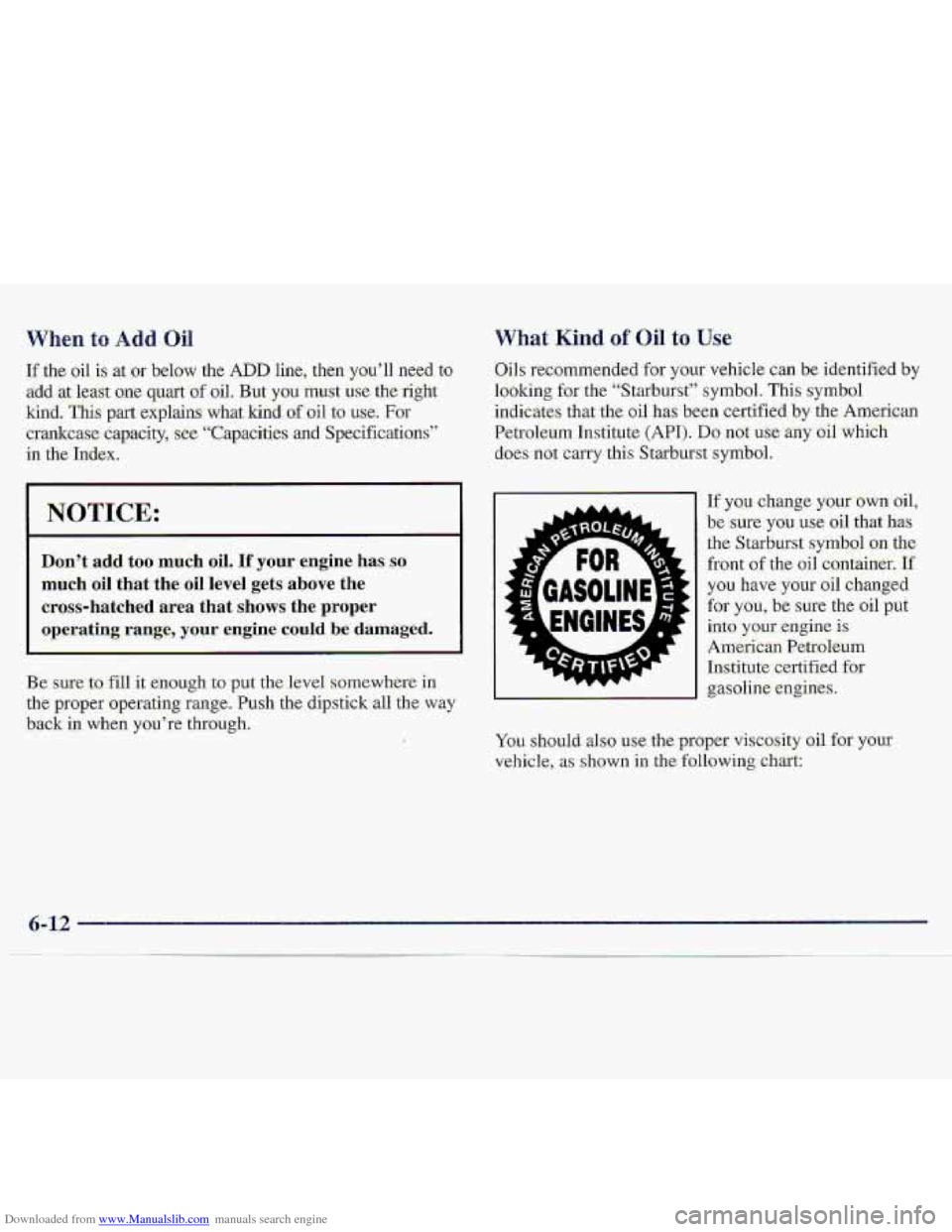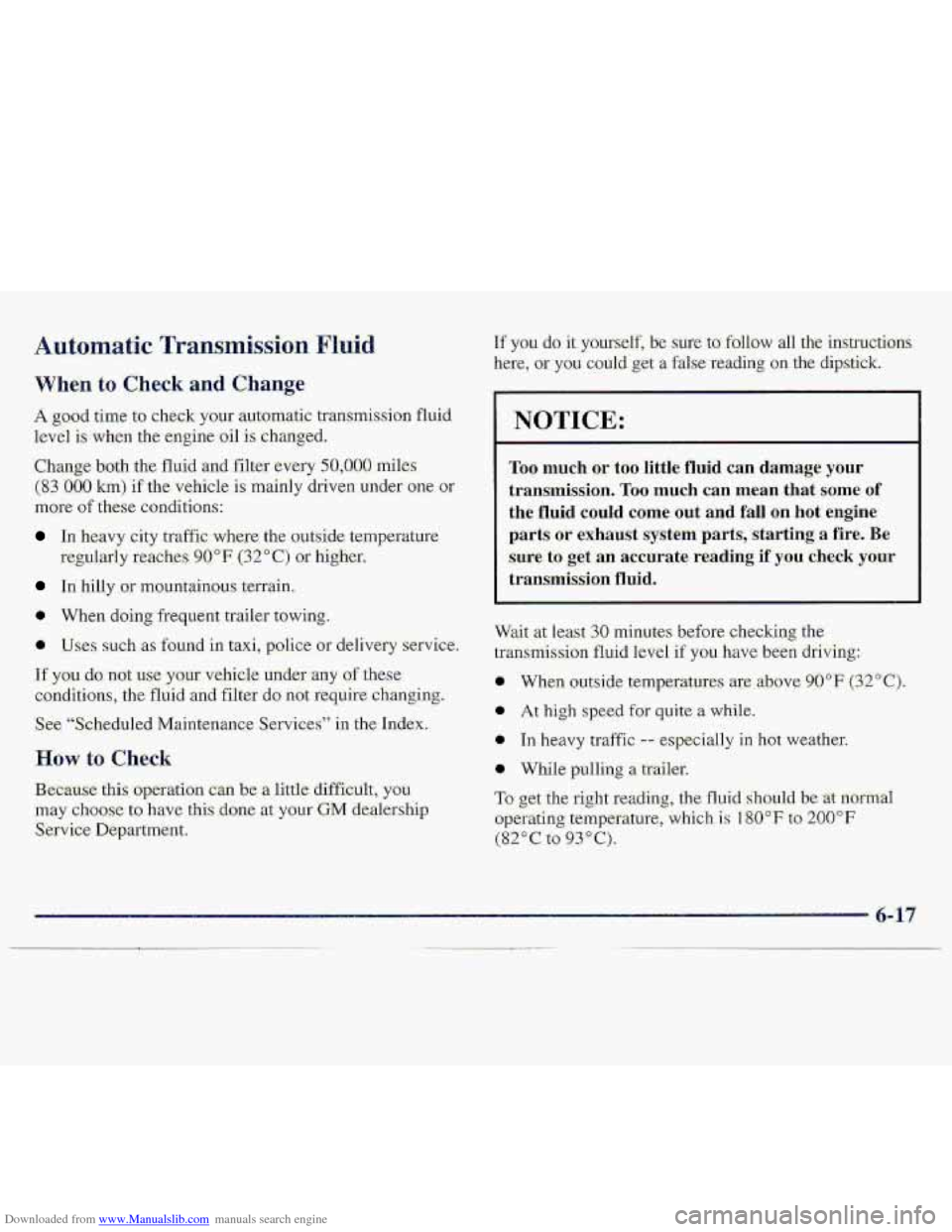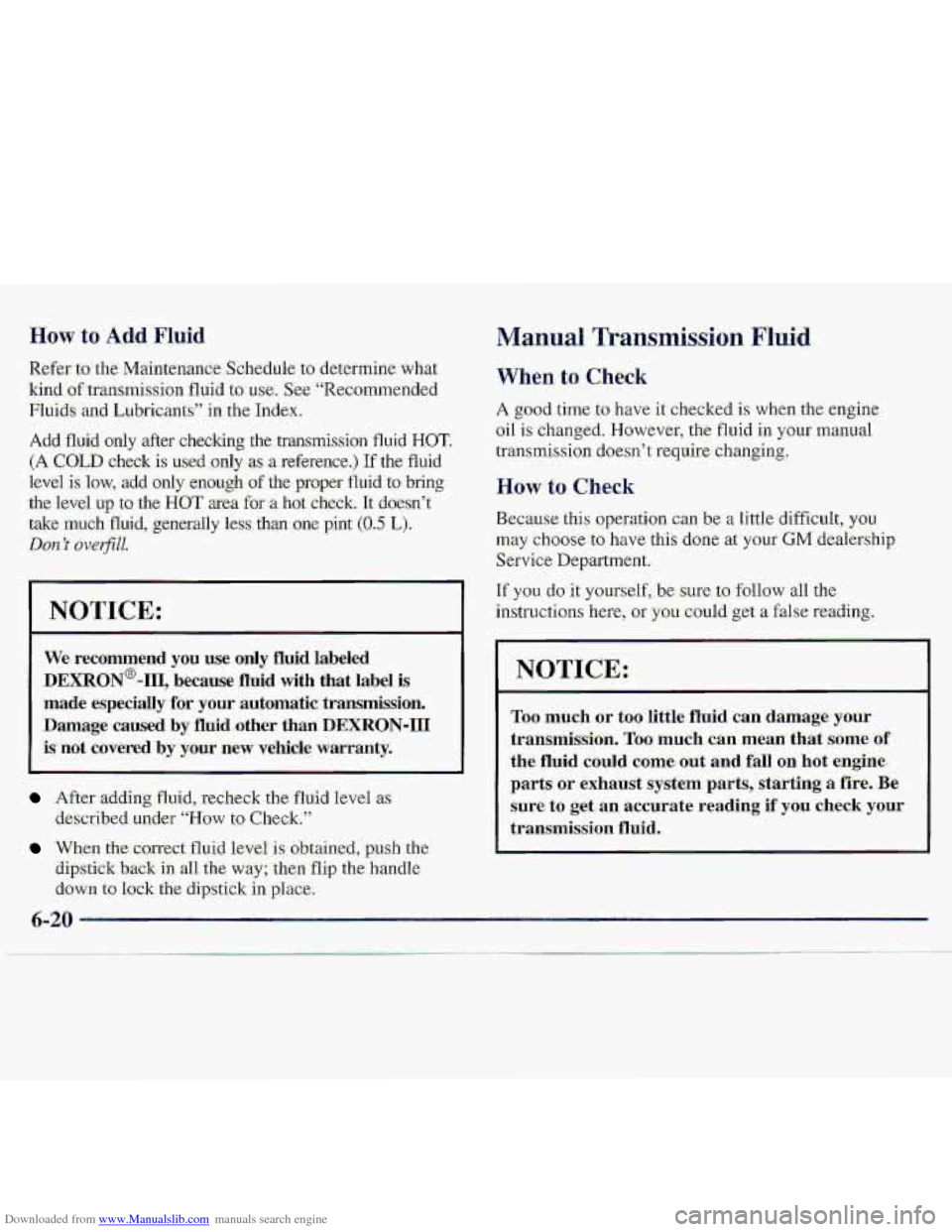Page 213 of 402

Downloaded from www.Manualslib.com manuals search engine How to, Add Csolsrnt to the Coolant
Recovery Tank
If you haven’t found a problem yet, but the coolmt level
isn’t at ADD, add a :SO/SO mixture. of clean wnrer
(prefer&bly .distilled) :and DEX-CC)OL@ (siljcate-frm)
antifreeze at the coolant recovery tank. (See “Engine
Coolant” in the Index for more information.)
r-
Adding only plain water to your cooling system
can be da-ngerous. Plain water, or some other
liquid like alcohol,
can boil before the proper
coolant mix win. Your vehicle’s coolant warning.
system
-is set.for the.pr0pe.r coolant mix. With
plain water
or the wrong-mix, your engine conld
,get too hQt but y.ou wouldn’t get the overheat
warning.
Your engine could catch fire and you or
others could be burned. Use a 50/50 mix of clean
water ana DEX=COOL@ coolant.
NOTICE:
In cold weather, water can freeze and crack.the
engine, radiator, heater
core and ather parts.
Use the recommended coolant and the proper
coolant mix.
Page 247 of 402
Downloaded from www.Manualslib.com manuals search engine Before cJosing the hood, he .sure- all the filler caps are on
properly. Thin lift the hood to. relieve pressure !on the
hood prop.
Remove: the hood prop: from the slot in the hood and
return the
prop to Zts reta.iner.
Then pull the hood down firmly to close. It wdl Iatch
when dropped from 10 to 1.<2 inches (25 to- SO cm)
without.pressing on th.e bod-
It’s a good idea to Cheek your- engine ‘oil-every time :you
get fuel. In order to get an accurate reading, the. o.iI must
.be warm and th.e vehicle ‘mu.st be an level ground.
The oil dipstick ,on the
“VORTEC”4300eng~,eis
a yellow ring.
6-10
Page 248 of 402
Downloaded from www.Manualslib.com manuals search engine The oil dipstick on the
2.2L engine is under
the
fill cap.
Turn off the engine and give the oil a few minutes to
drain back into the oil pan.
If you don’t, the oil dipstick
might not show the actual level.
Checking Engine Oil
Pull out the dipstick and clean it with a paper towel 01-
cloth, then push it back in all the way. Remove it again,
keeping the tip down, and check the level.
Page 249 of 402

Downloaded from www.Manualslib.com manuals search engine When to Add- Oil
If the oil is at or below the ADD line, then .you’ll need to
add
at least one quart of oil. But- you mut use the. right
kind.
This part explaimwhat kirdof’d to use. Fur
crankcase capacity, see “Capacities and Specifications”
in
the Index.
NOTICE:
Don’t add too much oil. If your engine has. so.
much dl that the oil-level gets above the
cr8s.s-hatched area that shows the- proper
operatiqg-rapgq, your engine cduld be damaged.
Be sure to fill it enough to~put the level somewhere in
the proper operating range. Push the dipstick all the way
back in when you’re though.
What Kind of Oil to Use
Oils recommended for your vehicle can be identified by
looking. for the “S.tarburst” symbol. This symbol
indicates that the oil
has been certified by the ArneriGm
Petroleum Institute- (API). Do no1 use any oil which
doesmot carry this Starburst symbol.
1
1 ‘4
C
If you change your own oil,
be sure you use oil that has
the Starbursl s-yrnbol .on the
front
of the oil container: If
you have your oil changed
for yo.u, be s.ure the oil put
into your .engine is
American Petr.oleum
Institute certified for
.gasoline engines.
You should also .use the proper viscosity oil for your
vehicle., as shown in the fgliDwing chart:
Page 254 of 402

Downloaded from www.Manualslib.com manuals search engine When to Check and Change
.A goad time to check-your a0tomati.c transmission fluid
level is when the en.gine .oil is chanzed,
C.hange
both the fluid an.d filter every 50,000-miles
(8'3 000 km) if the vehicle is mainly driven under one or
more of these conditions:
In heavy city traf€ic where the-outsi.de. temperature
regularly reaches.
906F (.32'C) or higher.
In hilly or mountainom terrain.
0 When doing frequent trailer towing.
0 Uses. such as found in taxi, police or delivery service.
If
you do not use your vehicle under any of the-se
cqnditions, the fluid and filter do not require changing.
See "Scheduled Maintenance Services"
in the Index,
How to Check
B.eCanse this operation can be a little difficult, you
may cho.Oge to have this dme at your GM de-alership
Service
Department
If you do it ywrsiAf, be sure to follow all the instruaims
here, uryclu coukd get a false re.adirig on the dipstick.
NOTICE:
Too much or too little fluid can damage- your
transmission,
TQO much can mean that s.ome of
the fluid could come out and fall on hot engine
parts or exhaust system parts, starting a fire. Be
sure to getan accurate reading if .you .check .your
transmission fluid.
Wait &t least.30 minutes before checking the
transmissioil fluid
level if.you have been driving:
* When ou&ide te:mperatures ar~ above 9C>-'F (32 O C).
0 At high spe>ed fbr.quite-.a while.
0 Tn'heavy traffic -- especidly in hot weather.
While pulling
a. trailer:
To -get the right reading, the flui,d'should be at dermal
operating temperature, which- is 1:80."F to 208°F
(82QG to 33°C).
Page 257 of 402

Downloaded from www.Manualslib.com manuals search engine HOW to Add Fluid Manual TransmisSion Fluid
Referto- the. M-aintenance Schedule t~ dtztermirie. what
kind of- tram~ssion fluid to. me. See “Recommended
Fluids and Lubricants:” in. the Index.
Add fluid only after checking tktrmsmission fluid HOT.
(A COLD check is used .only as a reference.) If the fluid
levd is low, add Only enough of the proper flvid. to bring
the le,vel up t.0 the HOT area fora hat check. It doesdt
take much fluid, ,generally less than Qne pint (0.5 L).
Don t ove.$ll.
NOTICE:
We recommend you use only fluid labeled
DEXRON@-III, because. fluid with that label is
made especidy
for-. your automatic transmission.
.Damage caused.
by fluid other than DEXRON-111
is not covered by y.our new vehicle warranty.
After srddiag fluid-, recheck the fluid Ievel as
When the-correct fluid level Ls obtained, .push the
described under “How to Check.”
dipstick back
in all the way; then flip the handle
down
to lock the dipstick in place.
A good time to have it checked is when-the engine
oil is changed. However, the fluid in your manual
transmission doesn’t require charging..
How to Check
Because this operation can be a little difficult, you
may choose to have this done at.you-r GM dealership
Service Department.
‘If YOU do it yourself, be sure. to follow all the
instructions here, or
you could ge.t a false reading,
NOTICE:
Too much or too little-fluid can damage your
transmission.
Too much can mean that same: u1
the fluid could come; out and fall on hot engine.
parts
or exhaust system p-arts, starting a fire. Be
sure
to get an accurate reading if you check your
tranqmission fluid.
Page 311 of 402
Downloaded from www.Manualslib.com manuals search engine I IMPORTANT: I
KEEP ENGINE OIL
AT THE PROPER
LEVEL AND CHANGE AS
RECOMMENDED
Protection
Plan
Introduction
Your Vehicle and the Environment
Proper vehicle maintenance not only helps to keep your
vehidle
in- gpad worbg condition, but also. helps the
environment.
All recommended maintenance procedures
are important. Improper vehicle maintenance
oan even
affect the
quality of the air we breathe. Improper fluid
levels or the wrong tire inflation can increase the level
af emissions from your vehicle. To help protect our
environment, and to keep your vehicle'in good
condition,
please maintain your vehicle properly.
7-2
Page 316 of 402
Downloaded from www.Manualslib.com manuals search engine Short Trip/City Maintenance Schedule
+ A good .time. to check your’ brakes is during tire
rotation.
See: “Brake System Inspection” under “Periodic
Maintenance Inspection” in Part C of this schedule,
** Drive axle setvice (see “Recommended Fluids ,and
Lubricants” in the Index for proper lubricant
to use):
0
0
‘Locking Differenti,al -- .Drain fluid. and refill at first
engine oi€ change.
At- subsequent oil Changes, check
fluid level and add fluid as neede.d.. If driving in
dusty areas or towing a trailer, drain fluid and refill
every
15,000 miles (25 000 km).
Standard .Differential -- Check fluid level. and. add
fluid as needed at every oil change If driving in
,dusty areas or towing a trailer, drain fluid and refill
every
15,000. miles (25 ‘000 km).
.More frequent lubrication may
be required for
heavy-duty or off-road use.